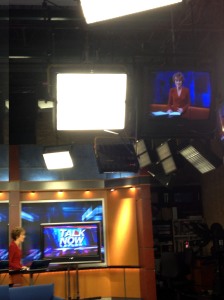Future of the entity called Television
March 14, 2012
the. Backdrop
Today for this blog, I am Twambi Kerstetter, the President and General Manager of Wichita’s KWCH-TV. For those of you who don’t know any information about this station let me fill you in. KWCH is the first television station in the state of Kansas. We began broadcasting on July 1, 1953. We are a CBS affiliate. So if you like CBS shows please stay tuned afterwards to watch the evening news with Roger Cornish and Cindy Klose. Also, catch your ever changing Kansas weather with Merril Teller and Ross Janssen.
KWCH-TV is owned by Sunflower Broadcasting, Incorporated. Sunflower Broadcasting, Inc. also consists of KSCW-TV and satellite stations KBSD-TV, KBSH-TV, and KBSL-TV. Through our offices, we currently run a Spanish affiliate, KDCU with Entravision. We operate four website which are KWCH.com, CatchitKansas.com, FetchToto.com, and KansasCW.com with three mobile applications (KWCH, Storm Team 12 and Catch It Kansas). We serve the state of Kansas; however our home community is Wichita. The Wichita metro population area is 664,000 people.
My team and I at KWCH thrive to meet our viewer’s needs and provide services that will keep them coming back to us. We want our viewers to choose us first especially when it comes to local news and sports. Technology is changing and giving people more power to seek out information plus other sources of entertainment.
definition. Television
The Oxford English Dictionary.com defines television as:
An system for reproducing an actual or recorded scene at a distance on a screen by radio transmission, usu. with appropriate sounds; the vision of distant objects obtained thus.
The Merriam-Webster.com definition of television is:
An electronic system of transmitting transient images of fixed or moving objects together with sound over a wire or through space by apparatus that converts light and sound into electrical waves and reconverts them into visible light rays and audible sound.
So television is the process by which images (record or photographs) are converted and transmitted over the airwaves to a television receiving set. This is the traditional way of television. This is changing. The delivery and the receiver are no longer people sitting at home on their television watching our channels. That is why we have four websites and three mobile apps. Our viewers can interact with us several ways. Not to say that people are not watching us at home on their television set. As Dave Morgan writes in his article TV’s Digital Age Will (Truly) Arrive 2017 that more Americans are watching more television than ever before.
What is changing the how.
current. Television
How people watch TV online and off by Erick Schonfeld writes that:
- Nielsen estimates that almost 145 million people watch video online in the U.S., compared to about 290 million who watch traditional TV.
- The top 5 video sites by unique visitors are YouTube, Vevo, Yahoo, Facebook, and MSN. But the top 5 video sites by time spent are Netflix, YouTube, Tudou, Hulu, and Megavideo.
Rather than being broadcast through airwaves, the internet is providing another avenue for people to reach us. YouTube spends $100 million to redefine TV by Marcho R. dell Cava writes about YouTube has recreated the traditional television digital. This is part of the way television is changing online. The internet is helping to redefine what the receiving mechanism.
Being in television doesn’t make me ignorant of the changes coming to us. My crew and I understand that as technology improves, it allows our viewers to have a diverse way to access us. I do believe that the delivery of “television” will change. The big box that sits in everyone’s living room is going to be redefined. It will no longer be a way we receive information but become more interactive allowing for more of a social experience that can be shared globally. It will also be mobile just like the ground-line became mobile through cellphones.
Rob Levine opening statement in his article The Future of Television is that television isn’t what it used to be. Levine also writes like newspapers, television channels are now reaching more viewers than ever before, but in a medium where they don’t like to pay for content and aren’t worth much to advertisers. Money will always be a driving force as we move forward.
adapting. Forward
Like any other business, Levine also explains that the future of television will inevitably follow the money. Money makes the world go round. As a television station, I need to think of what is the next big technology is going to affect me and how it will affect my revenue plus business. Mark Hachman gives the following 10 predictions in his article The Future of TV: No Networks, Remotes…or TVs?:
- Channels will go away
- Kiss the traditional remote goodbye
- Screens should be everywhere
- The 30-second ad is history
- Consumers will get involved
- Watch together, virtually
- Smell-o-vision?!
- Your content follows you
- Regular Joes go Hollywood
- Creation goes viral
If we look at what is going on with what people are doing. Then we can take note of the Xbox.
Currently provides its user an experience where the human body is the remote control. Through voice or jester of the hand, Xbox users can search and watch different channels like Netflix or ESPN. Half of Hachman’s this list has already started occurring.
I believe that television stations are going to merge with the newspaper industry. As the Average Joe goes Hollywood, we will still be the backbone to verify facts and hold up human integrity.
I also see that there would be a way to charge people for the news they get through their mobile device. As people once paid for magazine subscriptions, they will do the same for information.
By the time my children start going into the work force, their cellphones will not only be small but a valid way of receiving real-time news. I believe the form will be a microchip. The microchip will be able to receive and transmit information. They will have a mini camera that will be able to project images in front of the eye or a tablet as illustrate on the right.
So my goal is to be ready to meet the need for information and entertainment. I also understand that not everyone will be willing to move forward and need to make sure that my staff will be accommodating.
I also see our parent company or CBS purchasing web entities like Hulu or Netflix. They may create similar online opportunities for our local news and information to be accessed by anyone, anywhere. So, if a Wichitian lives in Antarctic, they will be able to watch our 10 o’clock broadcast live.
I see us hiring adjunct reporters. Just like colleges and university hire adjunct teachers to assist in teaching class loads. These reporters could have personal cameras that would record images directly to us. We will then take the B-roll images and construct news worthy stories for all our broadcasting avenues. The live footage will remain live. Our “On-the-Street” (adjunct) reporters will assist us in covering different local events when we don’t have the man power to do so. College students or people with a broadcasting background, who are not interested in full-time work, will make up of this team.
These are just a few of my thoughts and ideas. I will say that if you are interested in broadcasting, be prepared to be multifaceted. This will be the future saying of people in our industry: “I am a jack of all trades, master of none”.


